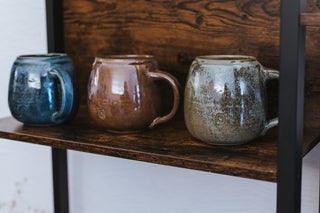Introduction
I can still remember my mother knowing exactly the differences between porcelain stoneware and earthenware.This knowledge seems to have disappeared from the public eye in the last thirty years.
Why you should know the differences and what to look for when buying, I explain in this article.
Tight, tighter, tightest
As mundane as it sounds, the only difference that matters to the consumer is the density of the fired clay.
The denser the clay becomes during firing, the more robust it is and the better it can withstand blows and impacts.
In addition, moisture cannot penetrate a densely fired clay body - and that is a good thing. Because moisture in the body can cause all sorts of problems. From cracks in the glaze to mold. Some is annoying, some is highly concerning.
The water absorption capacity of fired clay is measured in % of its own weight and can be influenced by the choice of material and the correct firing.
Earthenware: Not dense, but with history
Earthenware is known since mankind started to work with clay. There are different types of earthenware, like the Italian "Terra Cotta", Roman "Terra Sigilata" , German "Steingut" or English White - and Creamware.
Earthenware became especially popular through faience painting until the 20th century.
Earthenware is not vitrified,.
The water absorption is >10% of its own weight. The problems associated with this are manifold. Water that penetrates the unglazed areas of the shards causes them to swell. The result is cracks in the glaze, which are inevitable with earthenware. However, good earthenware lasts up to 20 years without cracking. Another problem is the growth of mold and bacteria in damp places. Stoneware stores moisture and only releases it very slowly. Mold and bacteria often form on the unglazed areas, such as the foot or in cracks.
Earthenware has a long tradition and is therefore often sold as particularly high-quality ceramics. In fact, earthenware is very cheap and easy to make. In daily use, it is problematic because it is not only hygienically questionable, but is also very susceptible to knocks and blows due to its porous structure.
If you like using stoneware, you should make sure that there are no cracks in the glaze and store it so that it can dry well. Under no circumstances should it be cleaned in the dishwasher.
Stoneware: Robust and versatile
Stoneware is a natural material. However, the commercially available masses are usually mixed. A mass is produced from different clays which has certain properties, such as a reliable firing range, a certain amount of grog or similar.Stoneware, however, may only call itself stoneware if it has a water absorption of less than 3% of its own weight after firing. Stoneware is thus considered to be dense. Good ceramists, however, achieve much better values. In some cases, for example, our ceramics can have a water absorption of less than 1% of their own weight.
This not only makes stoneware hard and robust, it can also be washed in the dishwasher without hesitation.
Stoneware is fired at temperatures of over 1200 °C, which costs a lot of energy. This drives up production costs.
But the effort is worth it, because the higher temperature is also beneficial for the glazes. Very durable, safe and robust glazes can be produced in the stoneware firing range.
Another factor that makes stoneware so popular is its versatility. It comes in a variety of colors and can create incredible textures. Read more about it in this article. Of all the ceramic materials, stoneware is certainly the most exciting. This also makes it our material of choice.
So, stoneware is a perfect material for making functional ceramics.
Porcelain: Noble in mind.
Porcelain originated in China. In the vicinity of the city of Jingdezhen, which is famous for its porcelain production, there are large deposits of Aluminium Dioxide, also called kaolin (probably after the village of Gaoling near Jingdezhen).Porcelain is bright white with a slight blue-grey tinge. Due to its extremely high density, it can be translucent and very durable.
The water absorption of hard porcelain is 0.01 - 0.09.
Porcelain-grade kaolin deposits are rare, which makes the raw material very expensive. Compared to the raw material price of stoneware, porcelain costs many times over.
Fortunately, the times when porcelain had to be fired at over 1300 °C are over. By adding fluxes, modern porcelain masses will vitrify between 1200 °C - 1250 °C.
Porcelain has a reputation for being difficult to work with, which we don't think is entirely justified. Porcelain is a great material and is wonderful to work with on the potter's wheel. If there's one negative thing to say about porcelain, it's that it's expensive and maybe a bit boring compared to stoneware. But that's a matter of taste.
Mixed with bone , the porcelain loses its blue-grey veil and takes on a warm, slightly yellowish color. Known as bone china.
Porcelain is considered the finest of all ceramic raw materials and is also an ideal material for everyday ceramics.

